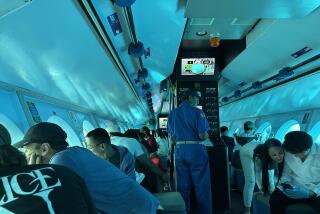Recovery From the Depths
- Share via
For as long as mankind has sailed the oceans, sailors have been buried at sea when storms, wars and accidents sank their ships. But advances in engineering and technology have made it possible to recover vessels from remarkable depths, with bereaved families in Russia and Japan the first to benefit.
The sinkings of the Russian submarine Kursk more than a year ago and the Japanese fishing ship Ehime Maru in February caused anger, grief and demands that the bodies of the victims trapped inside be recovered. That led to the impressive efforts in the Barents Sea and the waters off Honolulu.
Russia, which foolishly delayed seeking help from other nations when the Kursk sank and crew members might have been rescued, did seek assistance in raising the vessel. A Dutch consortium outfitted a giant barge that lifted the submarine on 26 steel cables from the ocean floor last month and hauled it to a dock near Murmansk.
The loss of 118 men in waters 350 feet deep for reasons unknown stunned and angered Russians, dashing faith in the military and the government. The recovery has helped repair some of the damage. The Kursk is the first nuclear submarine salvaged after sinking. A computer-assisted hoist system helped by keeping the cables under even strain. Divers had previously cut away the badly damaged bow of the submarine, lest it break off during the hoisting and send the sub to the ocean floor again.
In Honolulu, U.S. Navy divers have recovered the bodies of eight of the nine Japanese men and students who died aboard the Ehime Maru, sunk when struck by the U.S. nuclear submarine Greeneville on Feb. 9. The submarine was conducting an emergency surfacing drill for the benefit of civilian guests. The submarine’s captain was stripped of his command.
The Ehime Maru, which trained students in commercial fishing, sank in 2,000 feet of water, making the recovery all the more impressive. Remotely operated vehicles lifted the ship from the depths. Divers were able to reach the Kursk, but they could not have operated at 2,000 feet. The U.S. divers waited until the Ehime Maru was slowly moved to a shallower site, suspended underwater in a sling.
The raising of both vessels required patience and a knowledge of and respect for tides and bad weather that could have doomed the operations. Sailors have been divided on whether to break with the tradition of leaving bodies undisturbed, on an “eternal voyage” in the waters where they sank, or to take advantage of new technology to recover them and bring some solace to families.
The recovery was the right decision, demonstrated by the thanks of the relatives of the dead.
More to Read
Sign up for Essential California
The most important California stories and recommendations in your inbox every morning.
You may occasionally receive promotional content from the Los Angeles Times.













